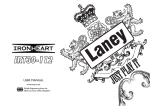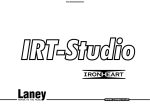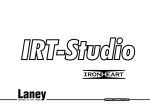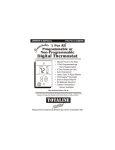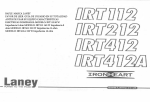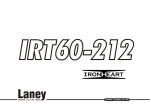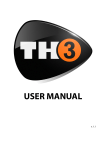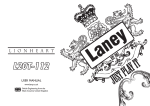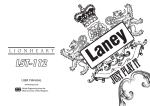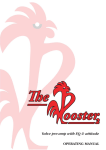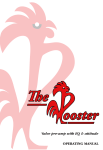Download IRT30-112 User Manual en.cdr
Transcript
Forged deep within the Black Country - the metal beating industrial heartland of the UK - where the sound of metal guitar was born, comes the IRONHEART. With molten metal flowing through its circuits, IRONHEART continues the legacy passed on by previous Laney amps such as KLIPP and AOR, and hits you hard between the eyes like a power hammer from hell. When cranked, the IRT30-112 possesses massive amounts of gain, but is equally at home providing smooth rock and clean tones. Like its 80's metal predecessor the AOR, each channel features 3-band EQ push/pull pots for extreme tone shaping and flexibility. Along with a Watts control, which allows the output of an IRT30-112 to be screwed right down to less than 1 watt output power, it also features a foot switchable Pre-Boost function which works just like kicking in a gain pedal in front of your amp. On the rear panel can be found sockets for the FX Loop, Loudspeakers, Aux In & Foot switch, along with a switchable DI which features cabinet emulation in the AMP mode. The IRT30-112 combo features two independent channel controls, with a switchable clean mode, for extra versatility. It is loaded with a 12" custom designed HH Acoustics speaker and the base of the cabinet is fitted with a special Tilting Mechanism, allowing the cabinet to be used in the upright or tilted back positions. Combine your IRT30-112 with an IRT112, IRT212 or IRT412 speaker cabinet for the ultimate tonal experience. FRONT PANEL CONTROLS 1. INPUT: 1/4" mono jack socket. Connect your guitar here. Use only a good quality instrument cable. 2. PRE-BOOST SWITCH: Switches the input boost circuit on or off. The Pre-Boost circuit increases the input signal to the preamp tubes, just like placing a boost pedal in your signal path. This drives the first preamp tube harder, resulting in more distortion. This works on both channels. 3. PRE-BOOST CONTROL: Controls the level of boost applied to the guitar signal. 4. PRE-BOOST LED: This LED will illuminate when the Pre-Boost controls are activated. 5. LEAD GAIN: Controls the level of preamp gain on the Lead channel. Turning this control clockwise will add more distortion to your guitar signal, ranging from light overdrive, to full on metal. Use this in conjunction with Lead Volume (8) to achieve the correct volume and distortion level you require. 6. LEAD EQ CONTROLS: These are a traditional set of passive tone controls. Passive controls have the advantage of always sounding musical at any of their settings, due to their unique interactive nature. This gives the player a more natural set of tools to shape their ideal sound. Set these to midway (0) as a good starting point. 7. LEAD EQ PULL SWITCHES: Pulling on each of the EQ control knobs will shift the response of each control as follows: Bass: Deep - This extends the low-end frequency response, resulting in a fuller, heavier sound for lower notes. Mid: Shift - This lowers the frequency range of the mid control to give a tighter sound. Treble: Shift - This broadens the Treble control frequency response, to give a rounder sound to higher notes, especially when used with thin sounding pickups. 8. LEAD VOLUME: Controls the Lead channel volume. Experiment with different combinations of the Gain and Volume controls to achieve different sounds. Reducing the Gain while increasing the Volume will result in a warm, open, overdriven sound as the power amp 4 is driven harder, while reducing the Volume and increasing the Gain will give a tighter, more modern sound with more distortion. Once set, try using your guitar's volume controls to interactively adjust tone and distortion levels. 9. CHANNEL SWITCH: Switches between the Lead and Clean/Rhythm channels. 10. CHANNEL LEDS: Indicates which channel is currently selected by the Channel Switch (9). 11. CLEAN/RHYTHM SWITCH: This switch activates the Clean mode on the Rhythm channel. When operated, the Clean Volume (12) control becomes active, while Rhythm Gain (14) and Rhythm Volume (17) are removed from the signal path. When using clean mode, the preamp gain is lowered, resulting in a cleaner tone. 12. CLEAN VOLUME: Use this to control the volume of the amplifier when using clean mode. The amp can still be driven to overdrive with the control turned fully clockwise, and can be driven harder by using the Pre-Boost. 13. CLEAN LED: This LED will illuminate when Clean mode is activated. 14. RHYTHM GAIN: as Lead Gain (5) 15.-16. CLEAN/RHYTHM EQ CONTROLS/PULL SWITCHES: as Lead EQ Controls (6 & 7) 17. RHYTHM VOLUME: as Lead Volume (8) 18. DYNAMICS: This allows control over the response of the amplifier at lower frequencies. Turning this control clockwise gives a looser low end, while lower settings provide a tighter response. The optimum setting is dependant on the speaker cabinet used. 19.TONE: This Tone control works in a similar fashion to the Tone control you probably have on your guitar except that it uniquely works at the other end of the amplification chain. This has the ability to not only control the overall top end response but also reduce upper harmonics on the output stage and preamplifier overdrive sounds. This will give you bright cutting sounds at high settings and smooth rounded sounds at lower settings. Midway (0) is a good starting point. Both the Tone and Dynamics controls depend greatly on the speaker cabinet connected to the amplifier. 20. REVERB: Controls the level of the built in Laney-designed digital reverb. 21. WATTS: The Watts control adjusts the signal level within the power amplifier, allowing it to be driven harder at lower volume levels. For full output power, running the power tubes at maximum levels, turn this control fully clockwise. To reduce output volume, turn this control to the left. This can be useful in practice environments, or when it is desirable to push the preamp hard but control the output level. 22. STANDBY SWITCH: Disconnects the main HT voltage from the tubes but keeps the tubes warm so that they are ready to play instantly. Switch for short breaks when you don't want to wait for the tubes to warm up again. With the switch in the 1 (up) position, the amp is in play mode, while 0 (down) allows the amp to warm up. 23. STANDBY LAMP: This will illuminate when the amplifier is in play mode. 24. POWER SWITCH: Main power switch for the unit. Tube amplifiers normally take between 30 seconds to 2 minutes to warm up and be ready to play after switching on. Use in conjunction with the standby switch to prolong tube life. To turn on, flip the switch to 1 (up). 25. POWER LAMP: This will illuminate when the power switch is operated, indicating that mains power is within the amplifier. REAR PANEL CONTROLS REAR PANEL CONTROLS L Z B1 2 3 4 Spare fuse located in the fuse drawer. 1. MAINS INLET SOCKET: Connect to your power source. Make sure the voltage indicated on the rear panel is correct for your country! 2. MAINS FUSE: This drawer contains the main safety fuse for the unit. The fuse protects the amplifier from damage in the event of fault by disconnecting the mains power supply. USE ONLY THE CORRECT SIZE AND RATING SPECIFIED ON THE PANEL. If a fuse blows or fails and a replacement of the same size and rating is installed which in turn blows, the amplifier has suffered a malfunction and needs immediate service from a qualified technician. DO NOT TRY A FUSE OF HIGHER RATING - Using a fuse that is too large in current rating may cause serious, irreparable damage to the amplifier and presents a serious fire hazard. The mains fuse ratings are detailed in the Specifications section of this manual, as well as printed on the rear of the amplifier. There is a spare fuse located in the fuse drawer of the mains power inlet in the event of a failure. 3. HT FUSE: This fuse disconnects the high voltage DC power to the tubes within the amplifier in the event of a fault. USE ONLY THE CORRECT SIZE AND RATING FUSE AS SPECIFIED ON THE PANEL. If a fuse blows or fails and a replacement of the same size and rating is installed which in turn blows, the amplifier has suffered a malfunction. At this point check the output tubes, and replace faulty ones if required. Should tubes not be the problem refer the amplifier to a qualified service technician. DO NOT TRY A FUSE OF HIGHER RATING - Using a fuse that is too large in current rating may cause serious, irreparable damage to the amplifier. Fuses are designed to protect, do not take chances. 4. DI: Use this socket to connect your amplifier to a PA system or recording interface. It features a SOURCE switch to select either the fully processed amp (featuring cabinet emulation) or raw guitar sound. It is fully balanced and features a level switch for -30dB (PA/Desk level) or +4dB (Line level) for driving powered cabinets directly. A ground lift switch is also provided for lowest noise performance. 5. AUX IN: A 3.5mm Stereo line input for connection of a CD or MP3 player as a backing track. Control the level of the input using the volume control on your CD/MP3 player. This input is present at the DI socket, but not at the FX send socket. 6. FX LOOP: FX RETURN: Mono jack socket for the connection of the output of an external FX unit. This can also be used as a slave in for the power amp. As the FX Loop is an insert type, this will mute the preamp signal. FX LOOP SWITCH: Selects the FX Loop mode of operation: -10dBu - For connection of FX units with a -10dBu nominal output level. As this is intended for devices with a lower output level, this switch increases the gain of the FX Loop by 10dB. 0 dBu - For connection of FX units with a 0dBu nominal output level. Bypass - Removes the FX Loop from the signal path. FX SEND: Mono jack socket for connection to the input of an external FX unit. 7. FOOTSWITCH SOCKET: Connect the supplied FS4-IRT here using the supplied 5 pin DIN cable. This allows you to remotely control the following functions: Channel, Clean, Reverb, and Boost. In order to use the footswitch functions correctly, set Pre-Boost and Clean to ON, and Channel to Lead. 8. LOUDSPEAKER CONNECTIONS: The IRT30-112 is equipped with a 12" custom HH Acoustics 8 ohm loudspeaker which should always be connected to the 8 ohm socket, with the impedance selector switch set to 8 Ohms, when used without an extension cabinet. When using the IRT112, or any other 8 ohm cabinet in conjunction with the internal speaker, use the 8-16 ohm socket with the impedance selector switch set to 4 Ohms. Mismatching your speaker impedance will reduce the performance of your amplifier, and in extreme cases may damage the unit. Never operate any tube amplifier without a load connected: serious irreparable damage may occur. (Always switch off and disconnect the power cord when not in use) MIXER DESK FX UNIT Internal Speaker Set impedance switch to 8 Ohms when using the internal speaker FS4-IRT IRT112 Set impedance switch to 4 Ohms when using the internal speaker with an 8 Ohm extension cabinet Tube amplifiers generally sound much warmer/sweeter than solid state transistor amplifiers but they also need a little more respect due to the fragile glass tubes. Use the following steps as a guide for how to take care of your amplifier: Take care when moving the amplifier. Tubes are fragile glass components, they can easily be damaged if thrown in and out of vans. Make sure the impedance of your cabinets matches the setting on your amplifier. Improper impedance matching will result in reduced output power and compromised sound at best, and amplifier failure/shortened tube life at worst. Allow the amplifier to warm up to room temperature before switching it on: the sudden thermal shock can crack a cold glass tube enclosure, plus any moisture is bad news around high voltage electronics. After playing, allow the amplifier to cool down before moving. Hot tubes are more fragile than cool ones. Always use good quality loudspeaker cables: instrument cables are not capable of handling the load requirements of the loudspeaker and can short out. A tubes life expectancy is based upon a number of factors which include operating temperature, how hard and how often it is played, vibration due to travel, etc. Tubes should be changed in your amplifier if you notice any deterioration in your amplifiers sound or performance. Otherwise, they need not be changed at any regular interval. Typical problems with preamp tubes can be crackly noise, hiss, hum, and microphony. If they fail or exhibit reduced performance, preamp tubes can simply be swapped out with no further action required. Typical output tube problems can include a blown HT fuse, sound lacking in punch, sound lacking extreme highs or low, and low level hum. The output tubes can be replaced singly if you replace them with the exact same type AND grade as factory fitted, otherwise they should be replaced as a matched pair. Supply Voltage:- Facto ry Mains Fuse: ~100V>~120V ~220V>~240V HT Fuse Power Consumption Output P ower Rating Features: ~100V, ~120V, ~2 20V, ~230V, ~2 40V 50/60Hz T1.6A L T630mA L T315mA L 100W 30W Pre-Boost Input Control Switchable Channels, with switchable clean mode Laney-designed digital reverb Tone Control Dynamics Control Equalisation Footswitch Loudspeaker Outputs Input Impedance Size Unit We ight Packed Weight "Wa tts" Outp ut Level Control DI - Switched AMP/INPUT 3.5mm Stereo CD/MP3 Line input Insert-type FX L oop (0dBu, -10d Bu, Bypass) Per chan nel: Passive Bass, Middle Treble with switchable Deep, Mid Shift & Treble Shift Master section: Dynamics & Ton e Laney FS4-IRT (included): Chan nel, Clean, Reverb , Boost 4-8 Ohms (swi tchable) 1M Ohm/47pF 473*578*2 88 (H*W*D) 20.5Kg 23Kg Carton Contents IRT30-112 Combo Amplifier FS4-IRT Footswitch 5 pin Footswitch Cable Mai ns Cable User Manual












